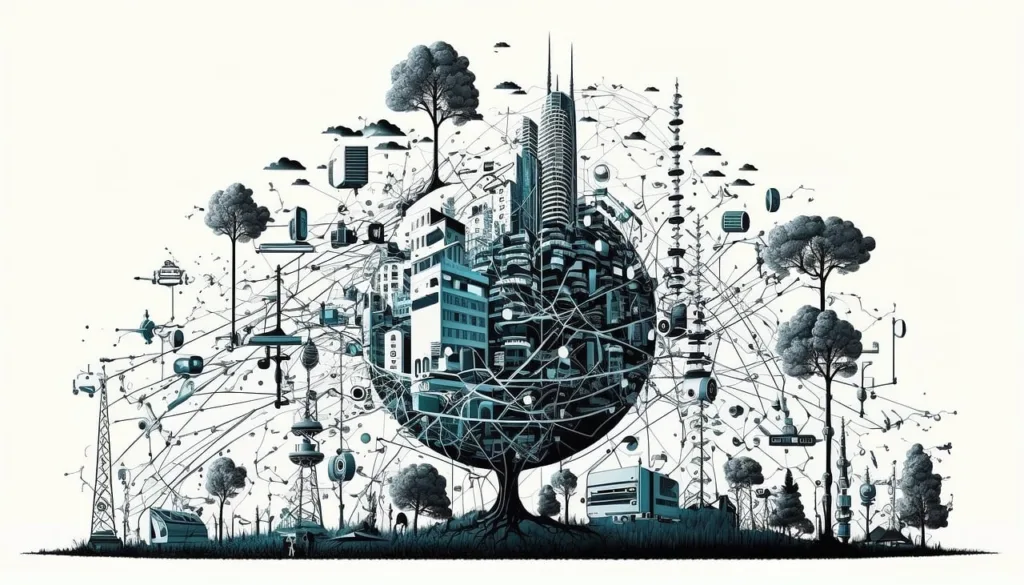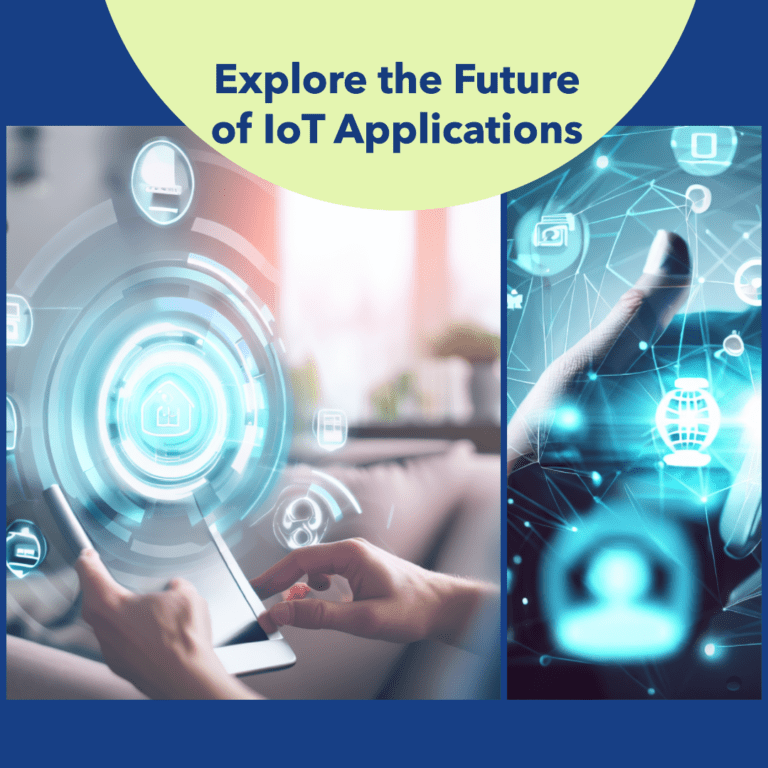IOT IN APPLICATIONS : The Evolution of Connected Devices
The evolution of connected devices has brought about significant changes in our daily lives. From smartphones to smart homes, these devices have become an integral part of how we interact with the world around us. With advancements in technology, we have witnessed a shift from standalone devices to a network of interconnected gadgets that seamlessly communicate with each other. This interconnectivity has revolutionized industries such as healthcare, transportation, and manufacturing, leading to improved efficiency and convenience for individuals and businesses alike.
One of the key driving factors behind the evolution of connected devices is the internet of things (IoT). The IoT refers to the concept of connecting everyday objects to the internet, enabling them to collect and exchange data. This has opened up a world of possibilities, allowing for the automation of tasks, real-time monitoring, and the creation of personalized experiences. As a result, we now have smart homes that can be controlled remotely, wearables that track our health and fitness, and cars that can navigate and communicate with each other. The evolution of connected devices has certainly made our lives easier and more interconnected, but it has also brought along new challenges and considerations, such as data privacy and security.
Enhancing User Experience with IoT Integration
As we continue to witness the rapid growth of the Internet of Things (IoT), the integration of IoT in applications is transforming the way we interact with technology. The seamless integration of IoT devices into our daily lives has the potential to greatly enhance user experience. With IoT integration, users are able to control and monitor their devices remotely, creating a more convenient and efficient environment. Whether it's adjusting the thermostat on the way home or monitoring home security systems, IoT integration offers a level of control and customization that was previously unimaginable.
Moreover, IoT in applications allows for a more personalized user experience. By collecting and analyzing vast amounts of data, IoT devices can learn user preferences and adjust accordingly. For example, smart home devices can adapt to individual routines and preferences, creating a more comfortable and customized environment. This personalized approach not only enhances user experience but also improves efficiency and productivity. With IoT in applications , our everyday devices are becoming intelligent companions, tailoring themselves to our needs and making our lives easier.
Leveraging IoT for Seamless Data Exchange
One of the key advantages of IoT is its ability to enable seamless data exchange between connected devices. With IoT in applications , devices can communicate and share information with each other in real-time, without any human intervention. This enables a wide range of applications, such as smart homes, smart cities, and industrial automation systems, to operate more efficiently and effectively.
By leveraging IoT for seamless data exchange, businesses can benefit from improved decision-making processes, increased productivity, and cost savings. For example, in a smart manufacturing setting, IoT-enabled devices can exchange data on production status, machine performance, and energy consumption, allowing manufacturers to optimize their operations and reduce downtime. Similarly, in a smart home environment, IoT devices can exchange information on energy usage, occupancy patterns, and security alerts, enabling homeowners to make informed decisions and enhance their living experience. Overall, leveraging IoT in applications for seamless data exchange opens up a world of possibilities for businesses and consumers alike, paving the way for a more connected and intelligent future.

Key Challenges in Developing IoT-Enabled Applications
IoT, or the Internet of Things, has revolutionized the way we interact with technology, bringing connectivity and intelligence to a wide range of devices. However, developing IoT in applications comes with its own set of challenges. One key challenge is the complexity of managing a vast network of interconnected devices. As the number of devices and the complexity of their interactions increase, it becomes increasingly difficult to ensure smooth and seamless data exchange. Developers need to find innovative ways to handle the scale and diversity of devices, while also considering the potential impact on performance and user experience.
Another challenge in developing IoT in applications is the issue of data security and privacy. With the constant flow of data between devices, there is a heightened risk of security breaches and unauthorized access. Developers must ensure that data transmission is encrypted and protected, while also implementing robust authentication and access control measures. Additionally, privacy concerns need to be addressed, as IoT devices often collect and transmit sensitive personal information. Striking the right balance between data accessibility and privacy is crucial in building trust among users and safeguarding their personal information.
In conclusion, developing IoT in applications presents unique challenges that require careful consideration and innovative solutions. Managing the complexity of interconnected devices and ensuring data security and privacy are two key areas that developers must address. By overcoming these challenges, developers can unlock the full potential of IoT, enhancing user experience and paving the way for a future filled with smart and connected devices.
Security Considerations for IoT App Development
With the widespread adoption of IoT devices, security has become a major concern for app developers. As these devices are interconnected and collect sensitive data, it is imperative to ensure that proper security measures are in place to protect user information. One of the key considerations is authentication and access control. IoT in applications need to implement strong authentication mechanisms to verify and validate user identity, preventing unauthorized access to the devices and data. Implementing multi-factor authentication and encryption techniques can significantly enhance the security of these apps and deter potential hackers.

Securing data transmission is another crucial aspect of IoT app development. As data flows between different devices and platforms, it must be encrypted to prevent interception and unauthorized access. Using secure communication protocols such as Transport Layer Security (TLS) or Secure Sockets Layer (SSL) can help establish a secure communication channel, safeguarding data during transmission. Additionally, regular monitoring and vulnerability assessments are essential to detect any vulnerabilities or security loopholes in the app. By promptly identifying and addressing these issues, developers can ensure that their IoT applications remain secure and protect user data from potential breaches or attacks.
Exploring IoT Protocols and Standards
IoT protocols and standards play a crucial role in facilitating seamless communication and interoperability between connected devices. With the vast landscape of IoT in applications, developers rely on these protocols and standards to establish efficient data exchange and integration across various platforms.
One of the widely adopted protocols in the IoT ecosystem is MQTT (Message Queuing Telemetry Transport). MQTT is known for its lightweight and efficient nature, making it ideal for low-power devices and unreliable networks. This protocol ensures reliable message delivery and enables devices to subscribe and publish to specific topics, allowing for efficient and real-time exchange of information.
Another popular protocol is CoAP (Constrained Application Protocol), specifically designed for resource-constrained IoT devices. CoAP relies on the lightweight RESTful architecture and UDP (User Datagram Protocol) to provide efficient communication and resource discovery. It enables devices to interact with constrained networks while conserving both power and bandwidth.
Apart from these protocols, standards like IPv6 (Internet Protocol version 6) are crucial for the growth of IoT. The adoption of IPv6 provides a vast address space, enabling a practically infinite number of devices to connect to the Internet. This standard ensures the scalability of the IoT ecosystem and supports the anticipated exponential growth of connected devices.
Exploring different IoT protocols and standards helps developers make informed decisions while designing and implementing IoT solutions. By understanding their unique characteristics and capabilities, developers can ensure interoperability, scalability, and efficiency in their IoT in applications.
IoT in Application Development: Choosing the Right Platform
When it comes to IoT application development, choosing the right platform is of utmost importance. The platform serves as the foundation for the application, determining its functionality, performance, and compatibility with different devices and networks. With a wide range of platforms available in the market, developers need to carefully evaluate their options based on their specific requirements and the target audience.
One key consideration while selecting an IoT platform is the level of support it offers for integrating different devices and protocols. A platform that supports a wide range of devices and communication protocols ensures seamless connectivity and interoperability, enabling the application to interact with various smart devices and sensors. Additionally, developers should also take into account the scalability of the platform, as it should be able to handle the growing number of connected devices and data streams efficiently. By choosing a robust and flexible platform, developers can lay a strong foundation for their IoT applications and ensure an enhanced user experience.
The Role of Cloud Computing in IoT App Development
Cloud computing plays a vital role in the development of IoT in applications. It provides a scalable and flexible infrastructure that enables seamless data storage, processing, and analyzing. By utilizing cloud services, IoT developers can offload the computational burden from the devices and leverage the power of remote servers to perform complex tasks. This not only enhances the performance of the IoT applications but also allows for efficient resource utilization.
Leveraging cloud computing in IoT app development also enables real-time data monitoring and analysis, which is crucial for businesses and industries. The cloud acts as a central hub where data from various connected devices can be securely stored and processed. This allows for quick decision-making based on real-time insights, leading to improved operational efficiency and better customer experiences. Moreover, the cloud also enables remote access to IoT applications, facilitating device management and control from anywhere, anytime.
Best Practices for Testing and Debugging IoT Apps
As the Internet of Things (IoT) continues to permeate various industries, the need for effective testing and debugging practices becomes even more crucial. Ensuring the functionality and reliability of IoT in applications is essential to provide a seamless user experience. To achieve this, developers should adopt a structured approach that encompasses both testing and debugging processes.
First and foremost, it is important to conduct thorough testing of IoT apps to identify any potential issues or bugs. This includes testing the overall functionality of the application, as well as its compatibility with different connected devices and protocols. Additionally, developers should consider conducting stress and load testing to gauge the app's performance under heavy usage scenarios. Through comprehensive testing, any vulnerabilities or weaknesses can be revealed and addressed before the app is released to end users.
Future Trends in IoT App Development
As IoT continues to advance and revolutionize the way we interact with technology, the future of IoT app development appears to be promising. One prominent trend that is expected to gain traction is the increased integration of AI and machine learning algorithms into IoT applications. This will enable devices to not only collect and analyze data but also make intelligent decisions and predictions based on that data. With AI-powered IoT apps, users can experience enhanced automation, improved efficiency, and personalized services tailored to their needs.
Another key trend on the horizon is the expansion of IoT applications beyond the traditional domains. While IoT has already made its mark in industries like healthcare, manufacturing, and smart homes, it is anticipated that more sectors will adopt this technology. For instance, transportation and logistics can benefit from IoT-enabled tracking and monitoring systems, while agriculture can leverage IoT to optimize crop yield and water usage. As IoT app developers explore new areas of application, we can expect a wide range of innovative solutions that improve productivity, streamline operations, and enhance overall customer experiences.
What is IoT app development?
IoT app development refers to the process of creating applications specifically designed for connected devices that can communicate and exchange data with each other, as well as with users.
How does IoT integration enhance user experience?
By integrating IoT into applications, users can benefit from seamless connectivity with their devices. This allows for personalized experiences, real-time data monitoring, and automation of tasks, ultimately enhancing convenience and efficiency.
How can IoT enable seamless data exchange?
IoT enables devices to collect and share data seamlessly through interconnected networks. This allows for efficient data exchange between devices, leading to improved communication, automation, and decision-making processes.
What are the key challenges in developing IoT-enabled applications?
Key challenges in IoT app development include ensuring compatibility across various devices and platforms, managing large amounts of data, addressing security concerns, dealing with scalability and interoperability issues, and incorporating real-time analytics.
What security considerations should be taken into account in IoT app development?
IoT app developers should prioritize security measures such as data encryption, authentication, secure communication protocols, user privacy protection, and regular software updates to mitigate potential risks and safeguard sensitive information.
What are some common IoT protocols and standards used in app development?
Common IoT protocols and standards include MQTT, CoAP, HTTP, Zigbee, Z-Wave, Bluetooth, and Wi-Fi. These protocols ensure efficient communication, interoperability, and data exchange between devices in IoT ecosystems.
How can cloud computing contribute to IoT app development?
Cloud computing offers scalable storage, processing power, and real-time data analytics, making it ideal for IoT app development. It enables seamless data management, remote monitoring, and access to resources, enhancing the functionality and performance of IoT applications.
What are some best practices for testing and debugging IoT apps?
Best practices for testing and debugging IoT apps include developing comprehensive test plans, conducting device compatibility testing, analyzing performance under varying conditions, implementing error monitoring and logging, and prioritizing regular updates and patches.
What are some future trends in IoT app development?
Some future trends in IoT app development include edge computing for faster and localized data processing, increased adoption of AI and machine learning for intelligent automation, integration with voice assistants and wearables, and the development of more sophisticated and secure IoT analytics platforms.





Pingback: How to Implement No-Code AI in Your Business Operations : Best Guide - techlooters.com
Pingback: Internet of Things Devices : 7 HIDDEN TrUths - techlooters.com
Pingback: How Internet of Things Changes our life : 9 Insane Facts - techlooters.com